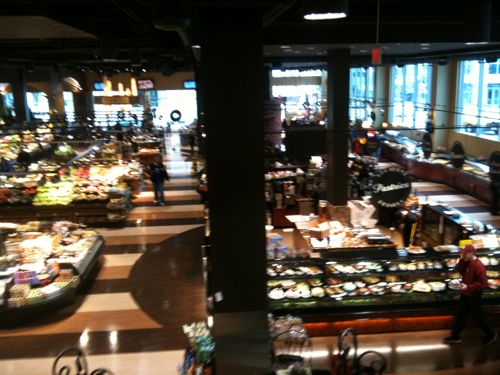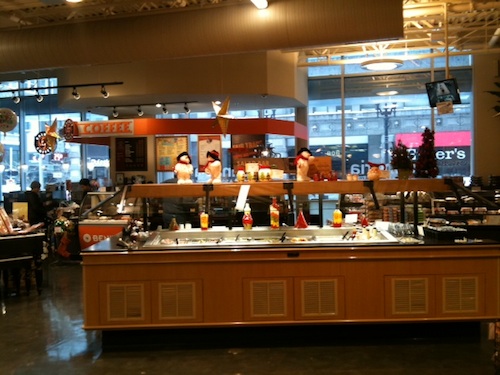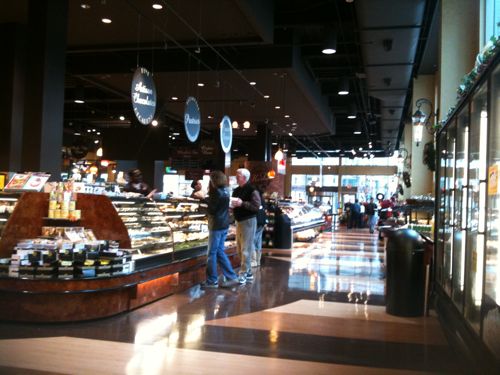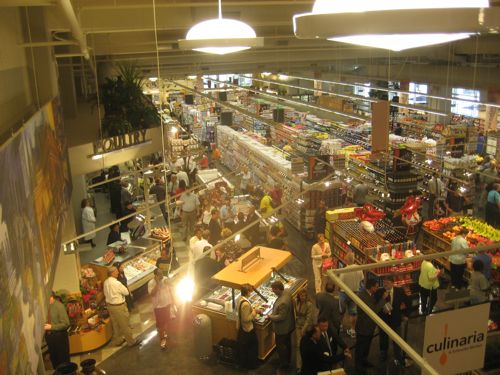Downtown Grocery Stores: St. Louis vs. Kansas City

On a recent visit to Kansas City I visited the downtown Cosentino’s Market in the Power & Light District. Â I was impressed., I left thinking the store had to be twice as big as St. Louis’ downtown market, Culinaria. Â It is bigger, but only 22% (27,000sf vs 33,000sf).
Both stores are operated by local family chains.

The older & larger chain is the St. Louis-based Schnucks:
“Associates of Schnuck Markets Inc., have been serving customers a unique combination of quality food, variety and value for nearly seven decades. Founded in north St. Louis in 1939, the family-owned grocery company has grown to include more than 100 stores in seven states: Missouri, Illinois, Indiana, Wisconsin, Iowa, Tennessee and Mississippi.”
But the Cosentino chain is only a quarter the size of Schnucks:
The Cosentino family opened their first market in 1948, located on Blue Ridge Boulevard in Kansas City. Since that time the local family owned grocer has aspired to provide excellent customer service in an exceptionally clean environment. It was with immense pride that Cosentino’s Market grew from a dream into a reality. The first Cosentino’s Market was opened in Brookside in 2004 followed by the location in the Kansas City Power & Light District in 2009. “We were so honored to be chosen as part of this historical project and to have the chance to develop such an innovative store.” John Cosentino says of the Downtown project.
Cosentino’s Food Stores currently operates 25 stores in the Kansas City area. The first generation is proud to watch the third generation of Cosentino’s Family members now taking part in the day to day operations and management of the company.
So the newer, smaller chain built a larger downtown market.

The Cosentino’s didn’t receive any direct subsidies.  However, it is part of the Power & Light District, which was financed in part through the state MODESA program.  Culinaria, on the other hand, got plenty of incentives.  First the parking garage it is located in is owned by  the Missouri Development Finance Board.  The structure was developed by DESCO, the Schnucks’ development company.  But they also got specific help:
Schnucks will pay $3.42 million necessary for tenant improvements, inventory and other opening expenses at the downtown location, at Ninth and Olive streets, according to state finance board documents. The remaining money will come from a combination of state, federal and city subsidies. (St. Louis Business Journal)

To my knowledge no criteria was put in place to have Schnucks repay the taxpayers if the store exceeded a certain threshold.
– Steve Patterson
Here, bigger is not better in my estimation. One of the things I like best about Culinaria is that it has everything I need but I don't have to walk through a huge warehouse to shop.
I can't say much about who is subsidising what. If Republican talking points about our nations extrodinarily high corporate tax are to be believed, it's no wonder tax breaks are necessary. And remember, if the grocery store wasn't built, the taxpayer would be losing even more revenue. Whatever percent of zero income is zero.
My only issue, and I look forward to the solutions, is what will happen if the downtown population grows by the numbers that are projected for the next decade. There are times now when the Culinaria is already over booked. Add another 6k or 8k residents and I believe we will need an addional grocery option. My choice would be a Trader Joe's somewhere between DT West and Lafayette Square.
But hey, the Culinaria is affordable, convenient, fresh and just plain fun to shop in. Love it.
Both stores are less than half the size of a typical new suburban store. I too prefer the smaller size but Culinaria is stuffing displays in formerly open space so they can sell more. As it is the sales are said to be double their expectations. So yes, I can see downtown and the surrounding neighborhoods supporting a second market. The question would be, does Culinaria move to a new space at Ballpark Village and a market like Trader Joe's take over the existing Culinaria?
That would make a lot of sense. Something a little bigger and fresher in BPV with the existing Culinaria space staying open for Wash Ave traffic, convention goers and lunch time crowd. Not to mention some good old-fashioned competition.
There is so much I love about the Culinaria, really, but the parking with validation makes it a nearly daily stop for me. Its so convenient to pop in and then continue home (Blu Cityspaces). When another place comes along, I hope the parking solutions are similar.
I would like to see Culinaria's books…double their expectations may still not make the store terribly profitable if the 'expectations' account for the subsidy…its hard to imagine the store not turning a profit, but they do have quite the hourly workforce (which I'm greatful for but is expensive) and not sure what the limited sales floor offerings do to margins…
Again, I would suggest this store has been worth every penny of investment…having an effective, normal-priced grocer in the neighborhood hits at the heart of the usual first objection to downtown living…practicality…with this grocery store, downtown living becomes more 'feasible' in many minds which helps break negative attitudes about 'the City' in general…which is good for the whole region…
I was told by a high level Schnuck's executive last year that Culinaria was already “almost” profitable. They had expected it to take up to 3 years. The main concern was the average “ring” (I think that's the term he used) was somewhere around $18, when in a “normal” Schnuck's it was around $32, IIRC. Meaning that it takes 1 checker to ring you out whether you buy $5 or $100 worth of stuff. They were going to work on raising that number.
Basically the store was exceeding expectations and everyone was happy.
I love Culinaria!!!
I work for a retailer as well and our metrics are 'basket size' and 'profit-margin'. The entire store is arranged to try and maximize the number of items in a customer's basket and to maximize the number of high profit items in the customer's product choices.
The other thing (in addition to the jazz musak) I think Culinaria does well is integrate into the neighborhood…They routinely promote the theme or feel of downtown whether its sports or holiday related.
My understanding is that Culinaria is expanding. Up, down, across, I don't know.
The store is too small for the volume and fitting it into a parking garage was less than ideal. There is no place to expand in the current structure. I see a new store in BPV with smaller chain taking over the existing space.
You've done your time in real estate, and you should realize that both location and subsidies are obviously big reasons why Culinaria works where it is now. Move it to BPV, and they would lose many of its current customers, especially those who are walking and not driving. I can see a second location possibly happening in BPV, but I sure don't see Schnuck's letting a competitor take over the current location, especially if revenues are double the original projections – see what's happening in Des Peres, where Schuck's built a new store down Manchester but apparently wasn't willing to lease their old location to Dierberg's, who's now building a new store across the street!
Bigger picture, I can see Culinaria's success possibly enticing other grocers to test the downtown market, with local chain Save-A-Lot at one end of the spectrum, Trader Joe's in the middle, and Whole Foods at the other end. The real challenge is demographics, both population numbers and disposable income – both need to increase. There are only so many dollars to spend, and they will only support a finite number of retailers. People in and around downtown aren't starving because there aren't any grocery stores, there just aren't a lot that are conveniently located (life's not fair). It's that old chicken-or-egg (pardon the pun) conundrum – what's more important, the property you're buying or renting or its nearby amenities? I've toured some really cool lofts, but they didn't have parking, so they didn't make my/our short list.
Convenient and quality food shopping is one of those things you miss if you've ever move away from it, and it's something many people ignore or minimize when they are looking to move. It's also something that anchors a neighborhood, and is really noticed when it closes. The real question then becomes whether or not government should provide incentives, and what kind, to either keep or attract grocery stores to challenging locations? These are for-profit businesses, and they do just fine, thank you, in finding profitable locations across the region with minimal government support. And as a resident of an area that already is well served by unsubsidized groceries, I don't see much reason why my tax dollars should go to building any more.
City Grocery was filling a niche downtown, but was run out of business by its government-subsidized competitor, Culinaria. Is that fair? I don't think so. Is Culinaria a better store? Offering a better shopping experience? Yes. Should government subsidize something even better nearby (TJ or WF)? And turn Culinaria from profitable to unprofitable? I think not. We'd all like to have our favorite stores closer (but not too close, as in across the street), but that'll never happen. Supply and demand, free enterprise, TIF's and NIMBY collide, and there are no easy answers . . .
Isn't the entire west half of that building's first floor pretty much primed/prepared for an expansion? I could be thinking of a different storefront, but I'm pretty sure that's the one — with high, wide windows and a large space inside?
That is the historic Syndicate Bldg, the other half of the block once shared with the historic Century Bldg that was razed in 2004.
Good call, Steve. I'm getting so used to seeing whole blocks dedicated to one building and its parking garage, I'm starting to forget that there can be more! Still, there may be a way for the Culinaria to expand into there…maybe through the center?
Though with the Culinaria to the east (not to mention OPO and the Roberts Tower), a bookstore to the west, a new bike station to the north and a great, local family-owned bar (go Jack Patrick's!) to the south, I'm eager to see what else could go in the Syndicate's street level there to truly make that block a new hub for downtowners.
Sidenote: Taking some street pictures from atop the Schnuck's garage, the Syndicate has a really spiffy communal garden/patio about halfway up. Of course, they probably don't like people leaning out over the roof of the garage and looking into it, do they?
I know it is unscientific, but how did the number of customers appear compared to Culinaria. I was surprised on a trip to Portland, that Pearl District Whole Foods didn't seem as crowded as Culiniaria for a similar time of day. The store was probably slightly larger along the lines of the Cosentino's. It also had glass garage doors that could open up it the weather was nice so the produce was almost on the street.
Now that downtown has Culinaria, and there's a coop near Crown Candy Kitchen, how 'bout getting Aldi's to put a store next to the Walgreens at 14th and Lafayette, and getting Save-a-Lot to put a store at Jefferson and Eads, to pick just one truly underserved urban neighborhood. Do the same thing in East St. Louis and in LeMay. It's not just loft-dwelling hipsters and office woorkers that need and deserve good food choices, people of color and people of more limited means also deserve better options, as well. And why not get Whole Foods or Trader Joes to build a store at Forest Park and DeBaliviere, to seve the Wash U / CWE area, along with transferring Metrolink riders?
This is not actually a reply to JZ but I couldn't get the “Post” button to work otherwise…
Anyway, the Cosentino's space looks to have better windows. What does it look like on the outside? As much as I like Culinaria, the ground-floor facade of that f*cking garage is designed like crap, both functionally and aesthetically. The colors are ugly, the doors and windows are too small, and the door and window wells are so deep you can't even see them from an angle. Also, why is the window behind the outside produce display perpetually papered over? Look, I know I'm being difficult, but who wants to feel like they're walking into a garage to buy groceries?
I believe Sappington's Farmers Market is considering a location near 14th and Lafayette (not sure exactly where, but it's near the Walgreen's). I've read that anyways. Actually a better, broader fit than an Aldi's, as it's affordable for “the people of more limited means” and all earthy for the hipster set.
Your correct on that one. Their is some renderings floating around on a mixed use development that incorporates Sappington Market, rooftop greenhouses and new residential space. It is the empty space south of City Hospital re-development towards downtown (Close to Walgreen's). Maybe Steve could post them.
I see BPV being a horrible pick and agree a lot with what JZ71 stated about it all. I give Sappington Market a better chance simply by pursuing a different market south of downtown which it can survive on while being just enough of a niche to get a few people coming and leaving downtown for the day to stop. The question then becomes, will subsidies drive for a Sappington Market hurt Soulard's Farmer's market or will a smaller market not too far away survive (Can't recall the name, but in a non descript windowless building). Their is always consequences, as JZ noted, no easy answers
This is an even better idea…There was a thread on UrbanSTL.com about this…very exciting…supposedly they want to grow product on the property, too?
JZ, I would vote for all of those options and bet both a 'low-end' and 'higher-end' grocer would succeed…
I hope that happens…
Tho I have seen many a person of color or limited means in the Culinaria…all are welcome there, no?
In theory, everyone is/should be welcome everywhere, after all everyon's money is green. In reality, we shop where we feel comfortable and where it's convenient. Discrimination can be both subtle and even not done consciously. Validated or metered parking can and does scare off some potential shoppers, as do products that are unfamiliar and/or appear to be too expensive. Whether and how EBT cards are accepted is a factor, as well. While Culinaria does offer a range of “normal” grocery items, it, by design, does also try to be somewhat upscale, everything from its name to its large deli section. That's why I threw out Aldi's and Save-a-Lot as probably better fits for the larger community surrounding the urban core, and why Sappington Market could also work well (I wasn't aware of their plans).
I do like that Culinaria is emulating the Whole Foods model, is local and is succeeding. What concerns me more is that much of our city does not have convenient, quality grocery stores available, especially on the north side. There are no Dierberg's, Whole Foods, Trader Joe's, Walmarts, Sam's Clubs or Costco's in the city, at all, and 1 Target, 4 Aldi's, 5 Save-a-Lot's and 9 Schnuck's (includinng Culinaria), for a total of 19. Of those, less than a third of those locations (Schnucks, Save-a-Lot and Aldi's, with two each) are north of Delmar. Demographics are a bear, however, so it's a challenge making an economic argument for more investment in many neighborhoods.
If you have a car, driving is always an option. But if your options are Metro or a cab, your options drop significantly. And with eating better being tied to mitigating both obesity and diabetes, the availability of quality, affordable food is a bigger issue than who has the better deli section. I don't have the answers, but I do think that this is more of a citywide issue than a downtown one.
Also 3 Shop'n'Saves (all on the south side, with the “Shrewsbury” location barely in city limits – I think) and 1 Straub's (also south of Delmar and certainly not affordable for all) with other assorted stores here and there, such as Vincent's in Soulard, ALPS in Tower Grove East, and the new local produce mart Maude's Market in Dutchtown.
Urban food deserts are a huge issue. So many reasons why and so few answers.
It does not make any sense how large subsidies can be doled out for entertainment districts but nothing can be doled out for quality, affordable grocery stores for all our citizens? I'm not against trying to ensure economic growth by giving the Cardinals a break on future earnings. It's likely IMO that those investments will make money in teh long run. But urban food deserts are a big problem that should be dealt with too.
I worked for a few years in north side parishes doing community outreach…There are some tough situations in our City with no easy answers…But Im convinced that part of the solution requires each individual to ignore subtle discrimination or overt discrimination and make smart choices for themselves re: education, employment and fiscal responsibility …Its important to remember that early American pilgrims, Westward pioneers, and today's growing African American middle class all had little in teh way helping hands…For the most part, they saw what they wanted and went out and took it…Waiting for a government or a preacher or a developer to save one from poverty and deliver one to the promise land will likely leave one old and poor.
In my store, attitudes, words and conduct have a lot more to do with gaining respect from me and my staff than method of payment or the car you drive…period. Subtle discrimination is tricky to nail down and is a two way street…If a customer perceives discrimination and gets either overly defensive or sulks out mad, there is little management or anyone can do to rectify the situation, no matter how many govt programs or community meetings we have…
Steve, Wouldn't a small neighborhood corner grocery store do the same thing? Stuff every nook and cranny with items to sell. I give thumbs up to Schnuck's and their sense of what they need to do, sell to downtown residents or workers?
As far as subsidies, KC is literally on the hook for the bonds that built P&L. I believe they will be making up the difference in revenue shortfall this past budget year. So their is a lot of subsidies going around on both sides of the state
The quality of the shopping experience has gone down greatly for me. I showed the manager how difficult it was for me to get to some items. I've shopped in other stores in my wheelchair and it wasn't such a challenge.
. . . but you probably drove to them. It's the classic urban challenge, where urban real estate costs more per square foot, so things are packed more tightly and vertically. For people with mobility challenges, the tradeoff is walking versus driving and navigating the megastore (with wider aisles and lower shelves) versus the narrow aisles and higher shelves of smaller, urban stores. Pick your poison?
I have shopped Straub's (CWE) & Trader Joe's (Brentwood) in my wheelchair as well as by car post-stroke. Both have good selections without resorting to placing cardboard box displays & wire merchandise holders everywhere.
Trader Joe's is everybody's darling, and similar in size to Culinaria, but avoids the labor costs that Culinaria's deli requires. Straub's is also similar in size, but at a higher price point, in an, I assume, a paid-for location. Culinaria is cramming their aisles to maximize revenues in a high-cost location. Whether they've gone too far is a matter of both perspective and ADA compliance, as well as, potentially, subtle discrimination. If it's difficult for people with mobility impairments to shop, and they stay away, then it becomes easier to cram more stuff in the aisles, for the majority of non-impaired to select from. The management needs to weigh your “difficult”ies against maximizing their profits.
Actually, if someone were guilty of 'subtle discrimination,' its likely they would make things worse for themselves and not easier…Generally, a few choice words to district level management will cause things to change in the store…At least that is the way it works in my organization…But it also can be a constant battle…And if the victims of such behavior simply take it…nothing will change…
It is a battle…bear in mind that the only other option is to raise prices…
I work for a retailer and sales have to grow. Period. A pretty sure constant in business are rising costs so, obviously, income must rise too or someone's getting laid off. One way we try to maintain sales growth is to put as much out on the sales floor as we can. If its in the stockroom its costing us money. If its on teh sales floor it has a chance to make us money. But frustrated customers hurt sales as well. If an elderly lady can't navigate her cart around my store or someone in a wheelchair has to make a big production to get in and out of the store, something is wrong.
Different retail stores offer different experiences. Save-A-Lot and Aldi's are cheaper than Whole Foods but they don't offer the same products or shopping experience.
Steve, you should be able to shop comfortably in the Culinaria…I would be shocked if the Store Manager there does nothing or blows off your concerns…I don't know him well, but have met him and he is a fine individual…
Yours, Inc. has just opened a new $1 million market on N. Broadway in the Baden neighborhood… they will also stock vegetables from the Lincoln University Extension community garden in NSL. Today's STL Bus Journal has more. Good stuff!